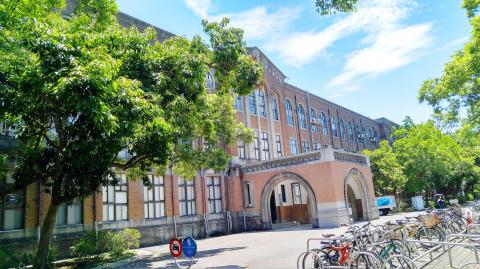In the imperial era, Japan founded nine imperial universities, of which seven were located in mainland Japan and two were in Japan’s overseas colonies. Taiwan’s first comprehensive university, Taihoku (the Japanese pronunciation of Taipei) Imperial University, was one of them.
During its establishment, the name “Taiwan Imperial University” was considered, but to prevent people from misunderstanding the name as meaning the “University of the Empire of Taiwan,” it was eventually named after the city in which it was located, hence Taihoku Imperial University. In fact, of the nine imperial universities, six were named after cities, such as Tokyo Imperial University and Kyoto Imperial University.
It was initially decided that Taihoku Imperial University would only have medical and agricultural departments, but then governor-general of Taiwan Izawa Takio insisted against all odds that the new university should be a comprehensive one. On March 16, 1928, Taihoku Imperial University, the first ever comprehensive university in Taiwan, was inaugurated and Japanese historian Taira Shidehara was appointed as the school’s first president.

Photo: Ethan Zhan, Taipei Times
照片:台北時報詹豐造
By 1944, Taihoku Imperial University had five schools, including the School of Liberal Arts and Political Science, the School of Science, the School of Agriculture, the Medical School and the School of Engineering, with 394 students, of whom, 277 were Japanese and 117 Taiwanese. Its library collection was ranked third among Japan’s nine imperial universities.
Taihoku Imperial University is now known as National Taiwan University. Its campuses are so vast that they account for one hundredth of Taiwan’s total land area. However, beginning from the 1980s, the school demanded that campus buildings should be built with common features, resulting in a striking resemblance between school buildings which has caused many people to become lost. Since Taiwan began holding direct presidential elections, four presidents have come from the school’s alumni, including incumbent President Tsai Ing-wen.
Translated by Ethan Zhan
日本在帝國時期共設立了九所帝國大學,七所在日本本土,兩所在海外殖民地。臺灣最早的綜合大學——臺北帝國大學——便是其中之一。
創校時,原本考慮將臺灣這一所命名為「臺灣帝國大學」,但為了避免造成誤會,被解讀成「臺灣帝國的大學」,因此決定以城市命名,是為「臺北帝國大學」。事實上,九所帝大中,有六所便是以城市命名的,譬如東京帝大、京都帝大。
原本臺北帝大定位為僅有醫學部、農學部的大學,但時任臺灣總督的伊澤多喜男力排眾議,決定將臺北帝大定位為綜合大學。一九二八年三月十六日臺北帝大開校,是臺灣第一所綜合大學,首任校長是日本歷史學家幣原坦。
至一九四四年時,臺北帝大已有五個學部,包括文政、理學、農學、醫學、工學,學生共三百九十四人,其中二百七十七名為日本人,一百一十七名為臺灣人。當時臺北帝大圖書館的館藏量在日本全國九所帝大中排名第三。
如今,臺北帝大更名為國立臺灣大學,校地廣大,佔臺灣總面積的百分之一。不過,由於一九八零年代開始,台大規定校內建築要有共通特性,因此校內建築相似度過高,造成不少人在校園內迷路。臺灣自從總統直選後,有四位總統都是出自台大,包括現任總統蔡英文。(台北時報詹豐造)

Even as he grows older, Microsoft founder Bill Gates still fondly remembers the catalytic computer code he wrote 50 years ago that opened up a new frontier in technology. Although the code that Gates printed out on a teletype machine may look crude compared to what’s powering today’s artificial intelligence platforms, it played a critical role in creating Microsoft in April 1975 — a golden anniversary that the Redmond, Washington, company celebrated on April 4. Gates, 69, set the stage for that jubilee with a blog post reminiscing on how he and his old high school friend — the late Paul Allen

Australia’s strict immigration policies have long been criticized, particularly for how they treat people with disabilities. Having been residents of Australia for years, Scottish Laura Currie and her Italian partner, Dante Vendittelli, recently experienced the impact of these immigration policies. Their son Luca, born in Australia and diagnosed with cystic fibrosis, became the reason their residency application was denied due to the anticipated high healthcare costs. Had Luca been healthy, there would have been no objections to their permanent residency. This case not only highlights discrimination against disabled individuals, but also raises questions about fairness and inclusion within Australia’s immigration

The study had several issues. Small sample sizes made it hard to draw __7__ conclusions. Additionally, taking a __8__ like pure MSG on an empty stomach is likely to make a person ill in any case. Choosing individuals who already had a history of the symptoms could have created a bias because they were likely to __9__ the reactions again. When real scientific research on the effects of MSG was eventually done, many of the myths surrounding it were proven __10__. The U.S. Food and Drug Administration and other global organizations have found MSG safe to eat. Today, MSG

1. 為了在最短期間精通日文,他非常用功。 ˇ He is working very hard (in order) to master Japanese in the shortest possible time. χ He is working very hard for mastering Japanese in the shortest possible time. 註: 用 for + 動名詞表示目的,是不合習慣的,應改用不定詞。請看下列句子: 農夫們拿起了武器來保衛他們的村莊。 The farmers took up arms to defend their village. 為了改進工作,我們修改了部分計劃。 We made some changes in our plan (in order) to improve our work. for 作「為了」解,後面跟名詞則是通順的。例如: 我們為這個計畫拚命。 We are working hard for this project. 我們正在為下一代創造更幸福的生活。 We are building a happier life for our children. 2. 他很怕冷。 ˇ The cold bothers him. ˇ Cold weather bothers him. χ He is afraid of the cold. 註: 我們在英漢詞典或中學課本中所看到的英文字詞的中文解釋,和它的英文原義往往只有局部相等。中文的「怕」只有在表達恐懼時,才能用fear 或be afraid of,不能隨便套用,請參考下面二例: 這錶不怕水。 The watch is waterproof. 我不怕熱。 The heat doesn’t